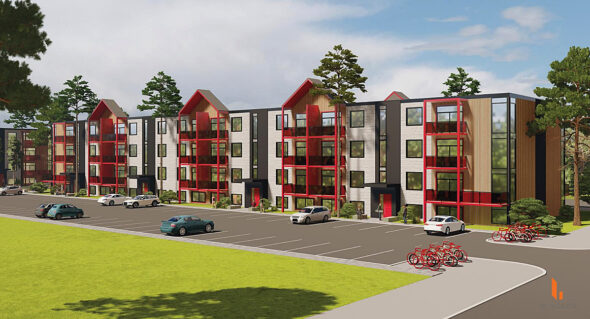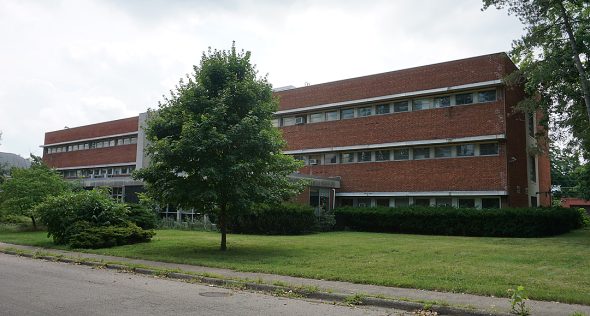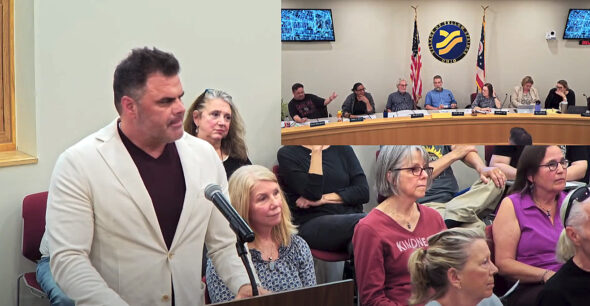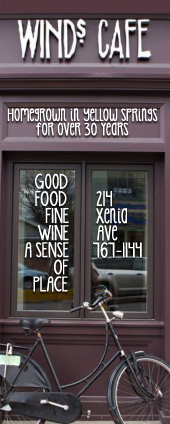
Shown above is the proposed “Unity Village” apartment complex Columbus-based real estate developer Windsor Companies intends to build on the site of the Antioch student union, once Windsor demolishes the existing structure. Ahead of last week’s Planning Commission, Windsor sought to create 128 apartment units between two separate, three-and-a-half-story, 64-unit structures — one of which is shown here — at the student union site. Owing to public pushback at the Planning Commission meeting, Windsor will return to the Village with a new plan — one for two structures totaling 96 units. (Rendering courtesy of Windsor Companies)
Villagers sound off on proposed apartments at Antioch College
- Published: May 28, 2025
Villagers packed Council Chambers on Tuesday, May 13, for the most recent Planning Commission meeting. Tensions were high, and ultimately, proposed plans changed.
At the meeting, commissioners were tasked with reviewing two preliminary plans for the rezoning and development of two sites at Antioch College — plans submitted by Columbus-based real estate developer Windsor Companies to build apartments at the site of the vacant Antioch student union, as well as in the Charles F. Kettering building.
As the News has reported over the last year, Windsor intends to demolish the derelict student union to build, in its place, two market-rate apartment complexes totalling 128 one- and two-bedroom units. For the Kettering building, Windsor aims to preserve and redevelop the structure to accommodate 43 apartments for individuals 55 and older.
Currently, Windsor owns the student union building and its 2.16-acre lot — purchased from the college last June for $500,000. The Kettering building remains under contract, as is the adjacent Sontag-Fels building — the latter of which Windsor has expressed interest in pursuing at a later date.
The primary purpose of Tuesday’s Planning Commission meeting was for commissioners to approve the rezoning of the two buildings — the student union and Kettering — from educational, or E-1, to planned unit developments, or PUDs, to accommodate added residential density and other variances on the land.
By a unanimous vote of 5–0, commissioners voted to approve the preliminary development plan for the Kettering building’s PUD redesignation.
Responding to sizable public dissatisfaction regarding the 128-unit density on the two acres at the student union site, Windsor CEO Alex Dorsey proposed, near the end of the meeting, a reduction to 96 units at that location.
Under that proposal, the two apartment buildings to be erected following the student union’s demolition — tentatively dubbed “Unity Village” — would be three-story buildings. The initial proposal was a three-and-a-half story building, with one partially underground; Dorsey’s 96-unit proposal eliminates that partial lowest floor.
Planning Commision members agreed to table the preliminary development and rezoning plans for the student union site until a future meeting when Windsor will return with an updated plan for the 96-unit Unity Village proposal.
In an interview with the News last summer, Windsor’s head designer Jason Dorsey estimated rents for all these units will range from $900 to $1,700 per month, though no Windsor representative spoke to those estimates at Tuesday’s meeting.

The Charles F. Kettering Building, at 150 E. South College St., built in 1950, was home to classrooms, administration and faculty offices, as well as scientific research laboratories. Now, it houses 91.3 WYSO. Currently under contract, Windsor plans to turn this building into 55-and-older residential apartments. (Photo by Reilly Dixon)
More on the Kettering building
Located on a 1.25-acre site at 150 E. South College St., the Charles F. Kettering building is currently home to 91.3 WYSO.
Windsor’s plan to rehab the building to accommodate 43 apartment units for people 55 and older includes maintaining the existing building’s footprint, demolishing a dilapidated rear garage and keeping 25% of the site preserved for open greenspace.
Of the 43 units spread over three floors, nine will be studios, 30 will be one-bedroom units and four will be two-bedroom units.
Windsor also proposed creating a community garden, and will keep the existing sidewalk intact.
The interior of the building will retain the existing elevator and wide hallways — design elements, Windsor partner Erik Alfieri told commission members, that make the Kettering building “uniquely suitable” for senior housing.
“This is adaptive reuse and preservation,” Alfieri said. “We think we can bridge the gap between preservation and providing high-quality, sustainable housing.”
Beyond seeking approval for those plans, Windsor went before Planning Commission to seek relief from several code restrictions — namely in the areas of density and parking.
Since the company seeks to create more dwelling units on the site than the Village zoning code allows — proposing 34.4 units per acre, as opposed to the permitted 14 per acre — Windsor sought a variance through the PUD designation.
Additionally, Windsor sought relief from the Village’s parking requirements, which specify a one-unit to two-parking-space ratio; Windsor intends to create 52 off-street parking spaces for its 43-unit development, and as such, included that variance in its PUD application.
Ahead of Tuesday’s meeting, Village staff recommended Planning Commission’s approval of Windsor’s preliminary PUD application, provided Windsor meets the following conditions for the Kettering Building site:
• The completion of a traffic impact study prior to the final PUD approval, with the implementation of any recommended mitigation measures incorporated into the final development plan;
• Ensuring that at least 15% of the 43 units be designated as permanently affordable for households earning 80% or less of the area median income;
• Providing 43 on-site bicycle spaces;
• And, prior to final development plan approval, obtain Village approval of a stormwater management plan.
“We have intent in the code that states we should encourage infill,” said Village Planning and Economic Development Director Meg Leatherman, who, along with other Village staffers, authored those recommendations.
“And this is an infill project — redevelopment within our Village boundaries,” Leatherman said. “If we want to address the housing supply issue that we have, that’s what we’re going to have to do. … Conservation easements around Village limits restrict our ability to grow and provide more housing opportunities. So I am recommending approval of this project.”
Following a public hearing, when a number of community members aired their concerns over the Kettering building project as well as Windsor’s intentions with the student union — namely those developments’ impacts on the surrounding neighborhood — Planning Commission members voted to approve the above four conditions, as well as a fifth.
From one neighboring resident’s request, Windsor is now required to build a screen — a hedge, fence or shrubbery — between the Kettering property lines and those to the south and west.
The preliminary development plan for the Kettering building will now head to Village Council for two public hearings and a final vote on the plan, as well as the rezoning.

With plans to demolish the site, Columbus-based Windsor Companies purchased the Antioch College Student Union for $500,000 last year. The developer plans to erect efficiency and one- and two-bedroom apartments in its place. (Photo by Reilly Dixon)
More on the student union
Like the Kettering building, the former Antioch student union is zoned educational.
It was built in 1957, and in the years since it closed its doors to students in 2007, has fallen into marked disrepair. Mold, asbestos and lead paint and piping litter the graffiti-covered building. The awning over the front stoop still reads “TRANSIENT MODE HOME.”
Owing to these conditions, Windsor intends to demolish the existing structure — pursuant to permits issued by the Greene County Building Department, according to Windsor CEO Dorsey — with measures in place to abate lead, mold and asbestos.
Village Council member and Planning Commission liaison Carmen Brown was supportive of Windsor’s intention to take the student union down.
“It’s become a huge liability for the village and for the campus,” Brown said. “This part of the project is important — not just removing a blighted building, but removing a health and safety hazard from the community. Kids are getting into this building.”
Before the eventual change in plans, Windsor’s proposal was this: Both structures on the student union site — Unity Village, taken as a whole — would be three stories tall, with one subgrade level, and each building would be composed of a 64-unit mix of one-bedroom and two-bedroom dwellings. Both buildings would be stairwell walk-ups, meaning there would be no elevator or internal hallways linking the units.
From Windsor’s request to build 128 dwelling units on 2.16 acres — going well beyond the allowed 14 dwelling units per acre allowed by the Village code in high-density districts — Windsor sought relief through an additional PUD application.
Also in this specific PUD application was another parking variance: For the proposed 128 units, Windsor aims to build 110 off-street parking spaces — substantially fewer than the code’s mandated two-to-one ratio, which would have required Windsor to build 256 spaces.
As with the Kettering building, Village staff recommended Planning Commission approve Windsor’s PUD request, provided they abide by similar conditions for this site:
• The completion of a traffic impact study prior to the final PUD approval, with the implementation of any recommended mitigation measures incorporated into the final development plan;
• A minimum of 15% of the dwelling units be made permanently affordable;
• A five-foot-wide sidewalk be constructed along the property’s frontage on both President and Livermore streets;
• The development provides 128 bicycle parking spaces;
• A stormwater management plan to be completed prior to final development plan approval.
Unlike the Kettering building plans for senior housing, the proposed 128-unit Unity Village proposal was met with considerably more opposition and scrutiny from both meeting attendees and some commissioners.

Windsor CEO Alex Dorsey, left, pitched the possibility of reducing the number of apartments at the student union site from 128 to 96. (Video still)
“An offense to the neighborhood”
Over a dozen Yellow Springs residents came to last Tuesday’s Planning Commission meeting — many of whom live on the surrounding roads of East Whiteman, President, East Davis, East Limestone, Livermore and East North College streets.
Though they aired different concerns — ranging from disrupted neighborhood cohesion to the area’s alleged inability to support a future boon of new residents and drivers — their message was consistent: Windsor’s plan to build 171 apartment units between the Kettering and student union buildings is all too much.
“These apartments are intended for urban environments,” Kim Kulasa said.
“I’m in favor of additional housing in the village, provided it is appropriately sited, designed and maintains the character of the community,” Jerry Papania said. “The proposed project meets none of this criteria. The neighborhood is going to look like Street Fair 24/7, 365.”
“This is an offense to the neighborhood,” Tom Degenhart said.
“It’s not considerate of the people who are there,” Wendy Delong said. “I haven’t been here a year, but had that monstrosity been peering over my neighbor’s house, I would have never bought the house that I did.”
Of all the remarks made during the public hearings on both the Kettering building and the student union’s rezonings — namely, regarding the eventual development plans — Desiree Nickell’s appeared to encapsulate the feelings of many in Council Chambers on May 13.
“The project does not seamlessly integrate with its surroundings,” Nickell said. “A development this big is suitable for a big city like Dayton or Columbus, not a small, rural village with a population of 3,700.”
Nickell continued: “Don’t get me wrong, I am 100% supportive of an apartment complex at the student union site. I just want to see it on the scale of other apartment complexes in Yellow Springs. … Anything more is a profit grab and certainly doesn’t conform to the values articulated in the proposal.”
Some Planning Commissioners were swayed by the outpouring of public pressure for Windsor to scale back its proposed plans. Commissioner Stephen Green asked Windsor partner Alfieri if their Unity Village project would work with fewer units; Alfieri was skeptical.
“It’s a feasibility thing,” Alfieri said. “The plan in front of you today … is one we believe we can effectuate. This is what we believe is the most financeable case in order to bear. If we do any less, it’ll become much more of a challenge in securing a bank loan.”
Commissioner Scott Osterholm took umbrage with some of the public pushback, citing his observed needs of individuals in the area seeking to live and work in Yellow Springs.
“The working class here is struggling. They can’t afford to move here and buy houses,” Osterholm said. “I want our locals back. We spend too much time kicking things down the damn road,” he said, referring to ongoing and occasionally unresolved housing discussions in Yellow Springs.
Planning Commission Chair Susan Stiles was resolute by the end of the public hearing — Unity Village’s 128-unit density on just over two acres was too much for her.
“Three-and-a-half stories is too big for me,” she said. “Not having at least 1.5 parking spaces for every unit … I don’t think I can support that. It just doesn’t fit into our town.”
Hearing all these concerns, Windsor CEO Dorsey returned to the podium with a middle ground: He said he’d “go back to the pencil” to take off the lowest level of the proposed apartments at the student union site, bringing down the height of the buildings and the overall unit count — from 128 to 96.
“I didn’t come here to refute,” Dorsey told Planning Commission, gesturing at those in attendance. “I want to make this work, and I want to work with you folks, but we have to work within the confines of what we can possibly do that is financeable.”
From that change of plans, Village Solicitor Amy Blankenship and Planning and Economic Development Director Leatherman agreed that it would be best for Planning Commission to table the proposal for the student union site, and later revisit the matter with an updated preliminary plan; Planning Commission members agreed.
The next regularly scheduled Planning Commission meeting is Tuesday, June 10. However, if there is a special meeting scheduled for the group to discuss the proposed rezoning of and preliminary plan for the Antioch student union site, the News will publicize that meeting in a public notice, and will report on it thereafter.
One Response to “Villagers sound off on proposed apartments at Antioch College”
The Yellow Springs News encourages respectful discussion of this article.
You must login to post a comment.
Don't have a login? Register for a free YSNews.com account.















The Village once again proves it 100% supports affordable housing….in the abstract. As an ex-pat living in diaspora I have no position on the issue, other than to say that I find the perpetual debate Groundhog Day’esque. “Babe, I got you babe….”